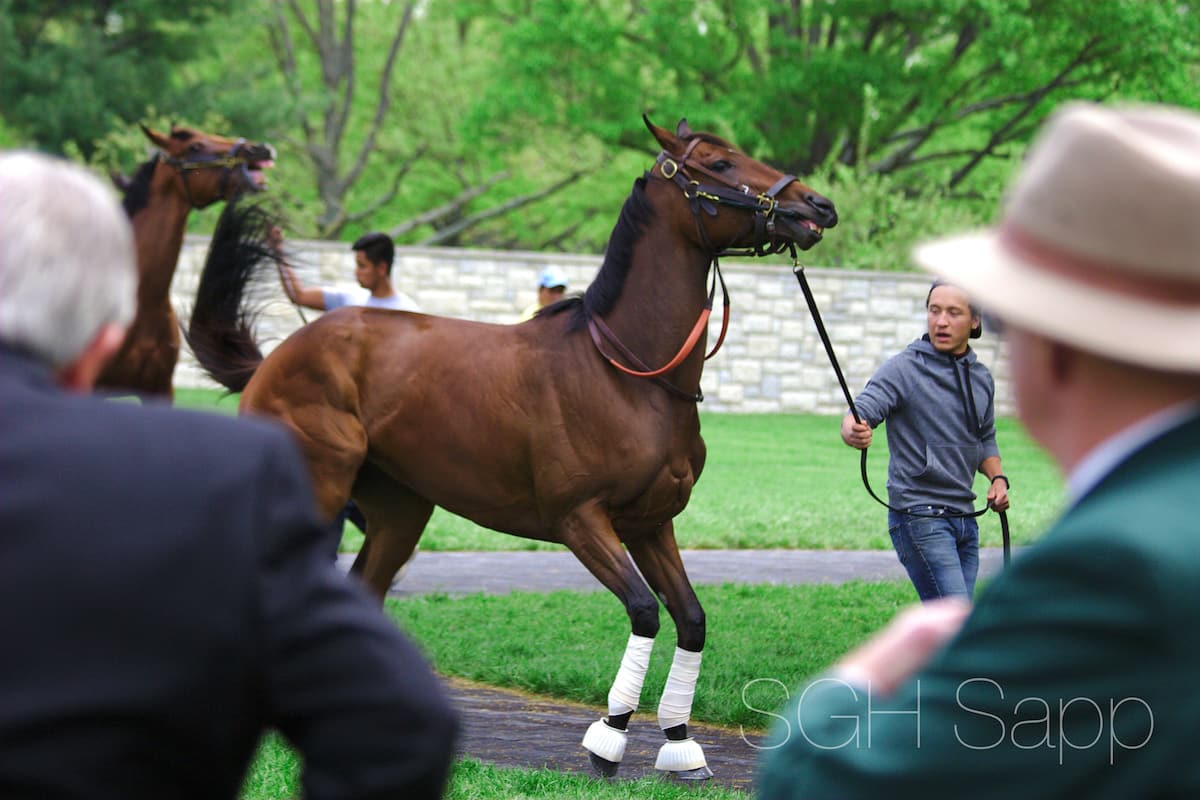The paddock provides a space for bettors and racing interests to evaluate horses

A horse that’s unprepared for the paddock environment might spook or become so upset as to perform poorly in the race. Sarah Sapp/Flickr CC
Skye Diamonds, a 3-year-old chestnut filly with a small white star on her forehead, didn’t know it, but her tour of the Del Mar walking ring in August 2016 would change her life. That was the day trainer Bill Spawr took a close look at her to decide whether he would risk $40,000 in the upcoming claiming race.
“Her legs were correct, her ankles looked good,” said Spawr, who trains horses on the Southern California circuit. “She was good-bodied and a really pretty filly.”
Spawr, who has trained such horses as 2011 Breeders’ Cup Sprint winner Amazombie, put in the claim, buying the daughter of First Dude. The filly won the race and afterward was led back to Spawr’s barn instead of her previous home. For a group of owners, Spawr trained Skye Diamonds to win seven more races.
That $40,000 became an excellent investment because Skye Diamonds ultimately earned $690,150 and later sold to Japanese interests as a broodmare prospect for another $500,000. Today Skye Diamonds is producing future racehorses in Japan.
Signs of Mental and Physical Wellness
That’s how crucial the paddock and walking ring can be in a racehorse’s life. It’s where trainers can view horses with an eye to claiming them. It’s where bettors can look at their selections to see if they feel a horse is worth backing.
Jon Lindo, one of Skye Diamonds’ owners after Spawr claimed her, is also a public handicapper who, on horse racing radio shows, often recommends horses he believes are worth betting on. Watching horses in the walking ring is important to his analysis of races and how well he thinks a horse will perform.
“The first thing I look for is health,” said Lindo. “You’re looking for a nice, bright coat, a horse that’s alert, a horse that looks healthy and happy. Maybe the physicality can make me lean one way or another.”
Lindo is comparing horses with what he saw in them before their previous races.
“Let’s say I see a horse that gets very (washed out) in the paddock and then he runs well,” said Lindo. “I know next time that I don’t have to worry about that because he’s already shown maybe that’s just how he is.”
Spawr or one of his assistants watches almost every horse in every race in the walking ring. They visually examine the horses’ condition, paying particular attention to their legs. Spawr relies on that information in deciding whether to consider a horse for claiming in the future.
“We make notes on each horse,” said Spawr. “We look at things like the shoes they have on, their temperament, even the equipment.”
If horses come over in a bridle with a simple snaffle or D-ring bit, that may indicate they don’t have any behavioral issues. Trainers might use more complicated bits to fix things like a tendency to veer in or out during a race. Spawr might prefer not to deal with those types of bad habits unless the horse has other good qualities.
The walking ring is also where races can be lost if a horse hasn’t received the proper schooling. A sudden noise could spook an unprepared horse, who might rear up or otherwise upset himself to the point he doesn’t perform well on the racetrack. Even worse, he could get loose and injure himself or someone standing nearby.
The Schooling Routine
Schooling in the paddock and walking ring is a part of every racehorse’s training. Grooms hand-walk their charges over to the walking ring to get them used to the procedure.
“I want them to relax when they run,” said Spawr. “If they use too much energy in the paddock and get upset, it’s not good. You school them according to the personality of the horse.”
Calm horses or those with plenty of experience need less paddock schooling than an excitable horse or a young one that is just learning what to do.
At most tracks the paddock and walking ring are two separate areas close to each other. Before every race horses are led into the paddock, which has a series of open stalls. The horses already have their bridles on, and trainers will saddle them there.
The grooms then lead the horses into the walking ring — a circular fenced area that usually has a dirt path just inside of the fence and a grassy area inside of that path. Fans can view the horses from outside the fenced area, while the horses’ owners, connections and trainers stand in the grassy area. Jockeys join them, receiving any instructions from the trainer and then a leg up before the horses are led out of the walking ring to the racetrack.
Usually, racehorses first experience the paddock and walking ring as part of their morning training. It’s a quiet time, allowing the horses to get used to the new experience.
“Most tracks during training hours will let you come back through the paddock after you’ve finished training,” said Spawr. “You can stand them in there and see how they act. Usually you have a pony with them, and they’re pretty good.”
In those cases the horse is already fully tacked with an exercise rider on his back.
Once a horse handles the paddock and walking ring in the morning, the groom will bring the horse to the paddock during an afternoon when racing is being conducted, without a pony. Before each race, a few horses that aren’t competing are allowed to come over with those that are. That way, they can experience the process with a crowd of people and the regular noise that occurs.
“I’ll know if the horse needs schooling just by training the horse and being around the horse,” said Spawr.
Each racetrack’s paddock and walking ring differ slightly, which is why many trainers school their horses in the paddock at every new racetrack. That can become especially important for big races like the Kentucky Derby or the Breeders’ Cup. Those large crowds are noisier than anything horses encounter in their other races.
In 2018 Skye Diamonds competed in a race at Churchill Downs the same afternoon as the Kentucky Derby. Later that same year, she raced in the Breeders’ Cup, also held at Churchill.
“She was pretty good,” said Spawr. “She was a little bit tense, but it was not a real problem. The big crowds really didn’t bother her.”
One Part of the Big Picture
The walking ring can be an important part of bettors’ or trainers’ day. Watching how the horse walks can influence whether they bet on horses or put in a claim. In a way, it’s similar to a prepurchase exam. You and your veterinarian want to see how a horse walks and jogs because that can reveal potential lamenesses as well as how athletic the animal is.
Trainers looking to claim horses might have already watched them gallop or work in the morning. They can also view the horses as they make their way from the barn to the paddock, something Spawr did the day he claimed Skye Diamonds.
The walking ring gives bettors and trainers a chance to look at all the horses in a race. They might be deciding between two horses to claim or bet on, and being able to compare them in the walking ring can be helpful. Horses that have learned their schooling lessons well could be ready to win, benefiting themselves, their trainers and anyone who bets on them.

